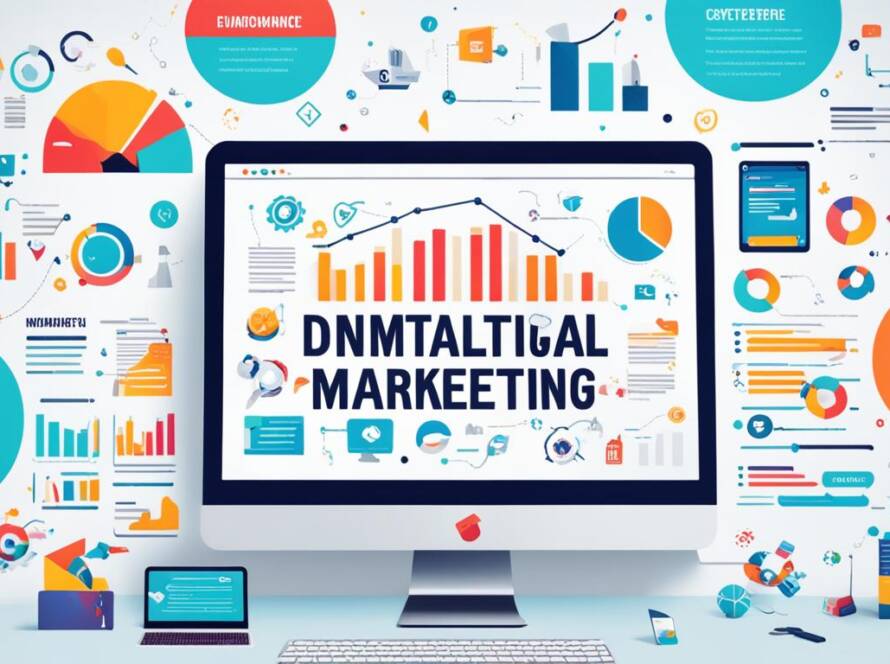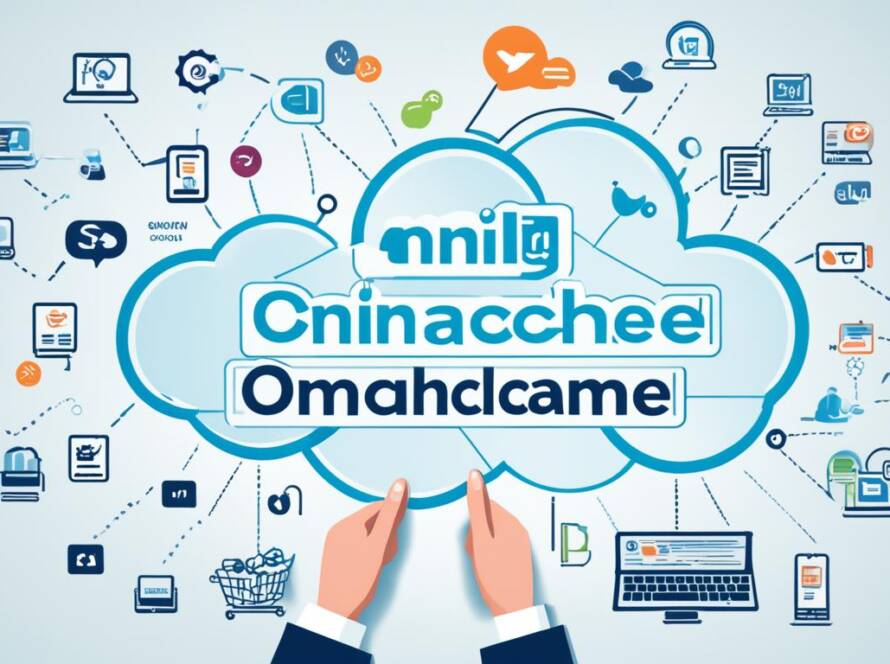In today’s fast-paced business world, building a strong omnichannel strategy is essential. Brands now see the huge benefits of giving customers a smooth experience across all touchpoints. This approach makes sure customers get a unified experience, whether they shop in stores, online, on their phones, or on social media.
McKinsey found that most Gen Z shoppers look at how easy it is to use a brand across all channels. This shows a big change in how people want to interact with brands1. Also, brands with strong omnichannel strategies keep about 89% of their customers across different channels1. This shows how important it is to have a good omnichannel plan for keeping customers.
Omni-channel marketing also helps brands get noticed more and makes customers happier and more loyal. This means they are less likely to switch to another brand2.

To build a strong omnichannel strategy, we need to work on two main areas. First, we focus on creating a business approach that values customers and uses technology to support the omnichannel experience.
Key Takeaways
- Gen Z consumers are shifting towards evaluating brands based on the seamlessness of their experience1.
- Robust omnichannel retail strategies help retain 89% of customers from channel to channel1.
- Omni-channel marketing maximises brand exposure and enhances customer satisfaction2.
- Integrated physical and digital experiences are driving the transformation of retail landscapes1.
- Adopting an omnichannel approach can significantly increase profits and sales volume2.
Understanding the Omnichannel Approach
In today’s market, retailers are realising the importance of an omnichannel approach. This strategy helps businesses give customers a smooth experience across different platforms. With shoppers using many channels, a good omnichannel strategy is key for staying ahead.
Defining Omnichannel Marketing
Omnichannel marketing means giving the same message across all ways customers interact with a brand. This includes online, in-store, social media, and email. The aim is to make the customer’s experience smooth and consistent, building loyalty.
For instance, 87% of retailers see omnichannel marketing as vital for their success3. Using a cross-channel strategy helps guide customers smoothly through their shopping. Brands that do this well keep more customers, with a big 89% for strong strategies4.
The Importance of a Holistic Customer Journey
Today’s shoppers expect a smooth journey across all touchpoints. A holistic approach ensures a consistent experience. Almost 90% of people prefer shopping this way, showing the need for seamless integration5.
Customers who use more channels spend more, by 9%3. This shows the benefits of a holistic strategy. Using Customer Data Platforms (CDPs) helps retailers understand customers better, making marketing more effective.
Technology is key to blending online and offline channels. Companies investing in omnichannel marketing have seen a big increase4. This shows a move towards a customer-focused approach in retail.
Using a structured omnichannel strategy boosts customer happiness and business growth. It uses various platforms for a personal shopping experience. By refining cross-channel efforts, brands can keep customers coming back for more.
Steps to Building a Strong Omnichannel Strategy
In today’s fast-changing retail world, having a *strong omnichannel strategy* is key for keeping customers engaged. Here are the steps we suggest to reach this aim:
- Begin by deeply understanding who your customers are and how they shop. Use tools like Cardlytics for marketing insights from over 179 million consumers6. This helps make your strategy match what your customers want and need7.
- Make sure your online and offline channels work together smoothly for a great shopping experience. Using new in-store tech like smart mirrors and Bluetooth beacons can really help engage customers in stores6. Mobile apps and websites are great for online interactions. A Harvard Business Review survey found that 73% of people shop across different channels, and those who look up a brand online often spend more in stores7.
- Use promotion software to manage and tailor your marketing across all channels. It’s important to segment your audience for more relevant content. A big issue is getting content that doesn’t match what customers want, so segmenting helps avoid this7.
A good omnichannel strategy uses many marketing channels, like social media, websites, apps, email, and more6. Our data shows that retailers with a strong omnichannel approach see better sales in stores and online7.
Business Insider reports that nearly 49% of buyers buy more often when brands talk to them across many channels7. A strong omnichannel strategy also keeps customers coming back, boosts sales, and builds loyalty, leading to more spending in stores7.
Last, track your success with metrics like cross-channel pageviews and social media engagement6. This way, we can keep improving our strategy. This leads to better *customer engagement*, more sales, and happier customers8.
Leveraging Technology for a Seamless Customer Experience
In today’s market, using technology is key for a smooth customer experience. Companies like Salesforce and Google Analytics are changing how we connect with customers. By using these tech tools well, businesses can greatly improve customer happiness and their own success.
The Role of Customer Data Platforms
Customer Data Platforms are vital for a smooth customer journey. They gather, manage, and analyse customer data from all touchpoints. This gives businesses a full view of each customer. It helps in making experiences personal and marketing more effective, boosting engagement and loyalty910.
Integrating Online and Offline Channels
Linking online and offline channels makes customer experiences consistent and smooth. By matching data and services across different platforms, businesses create a unified experience. Tools like CRM systems and AI help achieve this integration10.
Consistent Brand Voice Across Channels
Keeping a consistent brand voice across all channels is crucial for trust and loyalty. Tools like Hootsuite and Mailchimp help keep messages consistent. AI tools like chatbots also provide timely, relevant answers, fitting the brand’s style10. This approach improves the customer experience and strengthens the brand image.
In summary, using these technologies in a well-planned strategy can greatly increase customer satisfaction and loyalty. With the right tools and methods, businesses can offer an engaging and seamless experience that connects with their audience.
Conclusion
Creating a strong omnichannel strategy is key in today’s complex retail world. It helps businesses keep customers happy and loyal, like Nike and Disneyland have done. Using technology and a holistic approach boosts customer engagement and repeat sales, leading to growth.
Companies that use Customer Data Platforms (CDPs) gain valuable insights from various sources. This info helps improve marketing, products, and customer experiences, leading to more sales11. Combining online and offline channels gives customers a smooth experience, making them more satisfied and loyal12.
In the future, every B2C company will need a strong omnichannel marketing strategy. Keeping a consistent brand voice across all channels sets businesses apart and makes customers happier. This approach helps in building strong customer relationships and staying ahead in the retail game12.
Building a strong omnichannel strategy means focusing on the customer and using technology wisely. This approach makes customer interactions smoother, boosts engagement, and keeps customers coming back. Web Ai Engine leads the way in helping retailers succeed with omnichannel marketing, offering tools for a future full of innovation and customer connection11.
Source Links
- https://www.talon.one/blog/want-to-develop-a-strong-omnichannel-strategy-take-these-5-steps
- https://blog.hubspot.com/service/omni-channel-experience
- https://www.moengage.com/blog/omnichannel-marketing/
- https://www.channelsight.com/blog/omni-channel-approach
- https://www.bigcommerce.co.uk/articles/omnichannel-retail/
- https://www.cardlytics.com/blog/create-an-omnichannel-strategy-in-7-easy-steps
- https://www.moengage.com/learn/creating-a-omnichannel-strategy/
- https://crm-masters.com/how-to-create-an-effective-omnichannel-strategy/
- https://www.touchpoint.com/blog/omnichannel-customer-experience/
- https://inspiro.com/insights/blog/leveraging-technology-to-improve-customer-experience/
- https://www.teamworkcommerce.com/5-keys-for-a-successful-omnichannel-strategy/
- https://www.atropim.com/en/blog/digital-commerce/omnichannel-marketing-strategy



